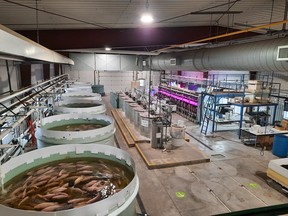Big fish to fry: Alberta’s aquaculture industry is making strides
High-tech approach increases yields and variety of stock

Article content
There’s an old joke about good salespeople selling sand in the Sahara. It so happens that Alberta’s developing high-tech aquaculture industry is now becoming competitive enough to sell tilapia to customers in Vancouver — and fresh shrimp to local restaurants.
Aquaculture raises aquatic organisms, such as fish and shellfish, under controlled or semi-controlled conditions. High-tech controls can increase not only yields, but the variety of species produced.
John Derksen, chair of the Aquaculture Centre of Excellence at Lethbridge College, notes that recirculation aquaculture — which relies on reusing water — is the most technologically advanced form of this type of farming.
“But if you’re raising fish, you need to clean that water, remove solids and add oxygen back in, because the fish are taking it out,” he says.
The centre’s demonstration facility added aquaponics in 2003, extracting nutrient-rich waste from the water to fertilize crops such as cucumbers as the system raises as many as 15 tonnes of tilapia each year.
“Once the system is in balance, high-tech controls and sensors monitor water, oxygen and ammonia levels,” says Derksen. “It’s challenging to get operations in balance, but once you’re there, it runs like an ecosystem.”
Fresh shrimp from Waterford Farms near Strathmore are also on the Alberta aquaculture table. Following a hiatus due to COVID-19 supply chain issues, owner Keith Driver recently restocked the facility with PLs — post-larvae baby shrimp. His goal is to reduce the environmental footprint of shrimp harvested overseas and transported to Alberta and supply ethically-raised fresh and live shrimp to local restaurants and supermarkets.
“We put a lot of money into creating a high-tech water treatment system that keeps the water at the right salinity and maintains water quality so the shrimp have a consistent environment to live and grow,” he says. “The IP is primarily in the control software we’ve developed. We recycle 98 per cent or more of the water we use. The system is also designed to avoid disturbing the shrimp as they eat, grow and are harvested.”
The facility is designed to expand with additional bio-secure, temperature-controlled and stackable modules, each with the capacity to produce as many as 70,000 lbs. of shrimp annually.
“We want to own and operate shrimp facilities in Canada and the U.S. for markets we know and understand,” says Driver.
But Waterford Farms has already been approached to license its technology to operating partners in the Middle East and North Africa.
“We can now monitor and control the shrimp facilities using a smart phone,” says Driver. “The more we can share monitoring among facilities, the better we can build our knowledge base and create replicable systems that are technology-enabled.”
The Canadian Aquaculture Industry Alliance notes that the country’s aquaculture sector already produces $5.2 billion in economic activity. Development of made-in-Alberta technology will continue to drive those numbers.






Postmedia is committed to maintaining a lively but civil forum for discussion. Please keep comments relevant and respectful. Comments may take up to an hour to appear on the site. You will receive an email if there is a reply to your comment, an update to a thread you follow or if a user you follow comments. Visit our Community Guidelines for more information.